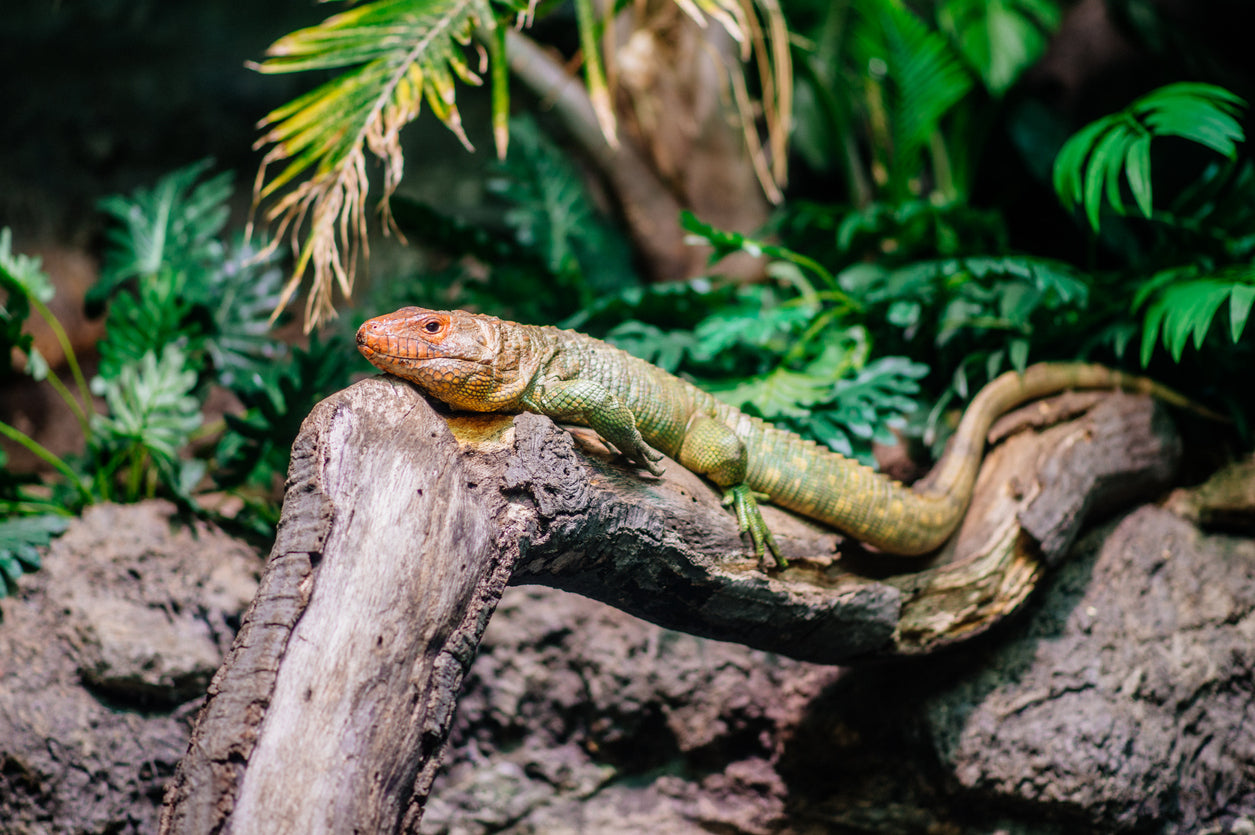As exotic pets, reptiles and amphibians are very different from the cats and dogs that you may be used to. They have a very different physiology, and as such they have an entirely different set of needs in captivity. Furthermore, the differences between types of reptile or amphibian is not like the differences between different breeds of cat or dog — each type of reptile or amphibian is an entirely different species, and can be as different from each other as a dog is from a horse.
If you are thinking about getting a pet reptile or amphibian, here are some general care tips you need to know.
Research Thoroughly Before You Buy
This can’t be stressed enough: before buying any pet, it is imperative to thoroughly research their care requirements! The last thing you want to have happen is to realize that you can’t provide appropriate care for your pet after you’ve already brought it home. Worse still, by not doing the right research beforehand, you could easily accidentally kill your new pet.
Research from a variety of sources, but also make sure that your information is coming from up-to-date, science-based sources, as these are the most likely to be correct. Sources that are simply one person’s opinion, or based on outdated practices, are not reliable. For example, ReptiFiles is a good place to start in terms of learning about science-based reptile care.
Consider Buying a Rescue or Rehomed Animal
There are lots of unwanted reptiles and amphibians in rescue facilities or listed in your local classifieds every year. These animals are looking for forever homes. Whenever possible, it’s best to adopt your next pet rather than buying one “new”.
If you can’t adopt an unwanted or rescued animal, buy it from a professional breeder rather than a pet store or online reptile distributor. Captive-bred reptiles and amphibians are healthier and generally do better in captivity than those that are wild-caught.
UVB Lighting is Important to Reptile Health
UVB can be confusing, which is why some people prefer to simply skip it, especially for reptile species that can technically stay alive without it. The problem here is that UVB is essential to maximizing your reptile’s wellbeing. UVB enables reptiles’ bodies to manufacture all of the vitamin D that they need, which is essential to a variety of processes like calcium absorption, nerve function, digestive function, immune function, etc. Supplementing vitamin D is helpful, but it’s best to cover your bases with appropriate UVB lighting.
Install Your UVB Lamp Correctly
First, you need to use the right brand of UVB lamp, as some are better than others. The most reliable UVB brands available in the US are Zoo Med and Arcadia.
Then you need to use the right strength of bulb. Generally speaking, nocturnal and forest-dwelling reptiles like leopard geckos and ball pythons need low-intensity UVB like the Zoo Med 5.0 or Arcadia 6%. Day-active desert-dwellers like bearded dragons and uromastyx need high-intensity UVB like the Zoo Med 10.0 or Arcadia 12%. In some cases, the Arcadia 14% may be more appropriate. Use according to the manufacturer’s recommended distance for your species’ optimal UVI (UV Index), and always install inside a fixture with a reflector to maximize output.
Unless you are using a very small enclosure (less than 12” tall and/or 18” wide), it’s best to use T5 HO linear fluorescent UVB bulbs. Avoid compact coil bulbs, as these have a very narrow range, and are unlikely to benefit your pet.
UVB bulbs need to be replaced every 6-12 months, depending on the manufacturer’s recommendation. Even though your UVB bulb may be giving out the same amount of visible light, the amount of UVB still decreases over time.
Don’t Forget Supplements
Your first priority is giving your pet a nutritious, varied, and balanced diet. Supplements are not a replacement for a high quality diet. They are, however, an important way to make sure your reptile doesn’t suffer from any deficiencies.
Calcium powder is important for balancing the calcium:phosphorus ratio in feeder insects and compensating for low-calcium greens. Some calcium powders contain vitamin D - choosing one with low amounts of vitamin D is a good way to augment your UVB in case you’re worried that you installed it wrong.
Multivitamins include a wide variety of vitamins and minerals to optimize your pet’s health. They should be mixed 50/50 with calcium powder for best results. Dose according to what’s appropriate for your pet’s species. Too little is usually better than too much.
Certain supplements, like Repashy Calcium Plus and Aradia Earthpro-A are both a calcium and multivitamin supplement in one product. Use these according to the manufacturer’s recommendations.
Monitor Your Temperatures & Humidity
Temperature and humidity always need to be measured using the appropriate equipment so they can be maintained where your pet needs them to be. Use a digital device with probes. Ideally, you should have at least two devices to measure temperature and humidity on both the warm and cool sides of the enclosure.
Infrared thermometers are useful for measuring the exact temperature of your basking surface. For best results, use a large, flat stone surface as the basking area and use the infrared thermometer according to the manufacturer’s directions.
Size Matters
Reptiles and amphibians need an environment that replicates the conditions of their native habitat, so they can’t simply roam your house like a cat or dog. However, the size of the terrarium you will need depends on the size of the animal and its activity level. Pay attention to the minimum enclosure size standards recommended by leading experts, and avoid outdated measures (for example, an outdated minimum for leopard geckos is 20 gallons, and an outdated minimum for bearded dragons is 40 gallons). Snake enclosures should generally be as long as the snake, and height should be half of the snake’s length.
Whenever possible, provide larger. Large, enriched enclosures encourage reptiles to thermoregulate more effectively and get more exercise, which makes for a healthier, happier pet!
Secure Your Enclosure
Reptiles are curious creatures that like to explore, so make sure that your enclosure is appropriately secure — especially for snakes and lizards! Your enclosure should have a secure lid. If it opens from the top and you have a snake, make sure to keep that lid locked down with a lock or screen clips. If the enclosure opens from the front, make sure it can’t be pushed open by the reptile inside with secure latches or locks.
For aquatic turtles, make sure the water level is low enough that the turtle can’t escape, especially from its basking area.
Handle with Care
Reptiles are usually fairly small, and that makes them delicate compared to other pets. When picking them up, either let them crawl onto your hand or very gently lift from from below. Grabbing or restraining often leads to injury, especially with chameleons. If your pet is uncomfortable with being handled, it may wiggle out of your grip and jump to the floor, which can also cause injury. Handling is stressful for reptiles and amphibians, so be patient and take the time to tame your reptile so it is calm during handling. Note that some species do not tolerate handling well, and should be left alone.
It’s best not to handle amphibians too often, as their skin is very fragile and sensitive. It’s best to wear gloves if you need to handle them.
Always wash your hands before and after handling your pet!
Be Mindful of Enclosure Placement
Enclosures should be kept away from windows and direct sunlight. The glass creates a dangerous greenhouse effect inside your pet’s habitat, potentially creating dangerously high temperatures. There is also no UVB benefit, since UVB rays are blocked by glass.
It’s also best to place your pet’s enclosure in a quiet part of the house. It shouldn’t be super busy or loud, as these can make your pet unnecessarily stressed.
Never Stop Learning
If you are not sure of something, don’t be afraid to ask, and don’t take constructive criticism personally. There are so many resources from which you can learn. One thing to bear in mind, however, is that a lot of what you read online may be conjecture or opinion rather than fact.
Ensure that you have researched thoroughly and learned from a trusted source. Herpetological societies and licensed veterinarians can be your best sources for information, as well as communities online where people share their own tried and tested methods.
Take Your Pet to the Vet at Least 1x/Year
Like other pets, reptiles and amphibians need to see the vet at least once every year. This helps monitor your pet’s health and keeps problems like excess weight gain or parasites in check. Make sure you take your pet to an experienced exotics veterinarian, not just a regular vet, as most vets only specialize in cats and dogs.




Leave a comment
All comments are moderated before being published.
This site is protected by hCaptcha and the hCaptcha Privacy Policy and Terms of Service apply.